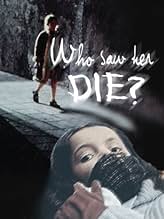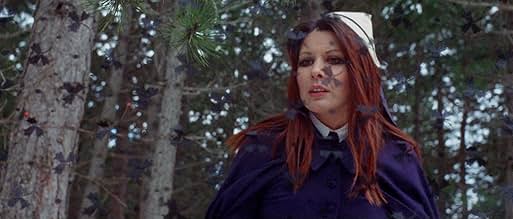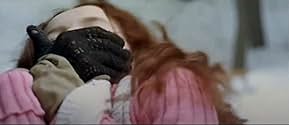Aggiungi una trama nella tua linguaA Venetian sculptor and his estranged wife pursue a mysterious, black veil-clad figure who has been murdering red-haired little girls - with the most recent victim being their daughter.A Venetian sculptor and his estranged wife pursue a mysterious, black veil-clad figure who has been murdering red-haired little girls - with the most recent victim being their daughter.A Venetian sculptor and his estranged wife pursue a mysterious, black veil-clad figure who has been murdering red-haired little girls - with the most recent victim being their daughter.
- Regia
- Sceneggiatura
- Star
- François Roussel
- (as Giovanni Forti Rosselli)
- Police Commissioner De Donato
- (as Sandro Grinfa)
- Andrea
- (as Georg Willing)
- Moviegoer
- (non citato nei titoli originali)
- Angry Moviegoer
- (non citato nei titoli originali)
Recensioni in evidenza
Unfortunately, there's some flaws that detracted from the experience for me. Lazenby does not speak Italian, so his lines are dubbed. At times, the sound level appears to be much too high, making the dubbing glaring. Similarly, the soundtrack is at times overbearing, particularly during appearances by the killer, whose discordant "theme music" became incredibly annoying, particularly when the rest of the film was marked by such a light touch. Mercifully, this problem is rectified at the climax and the music is cut short.
On the visual side, watch for some very fake looking blood. Many scenes (particularly interior scenes) are very dark, which caused me some problems in determining what was going on, but again this may have been compounding by watching on videotape rather than the big screen.
Overall, a satisfying mystery film, if a little slow-paced.
Lent a hand with terrific selection of film locations, filmmaker Aldo Lado demonstrates a keen eye for arranging shots and scenes; the basic visual presentation is itself fair reason to watch. This includes fetching hair and makeup work, costume design, and art direction, and more so instances of violence, and those few stunts that we see. The ensemble give swell performances of controlled range and personality, with George Lazenby unexpectedly making at least as much of an impression as co-stars like Anita Strindberg. And especially with all this in mind, in those scenes of most immediate peril for one character or another, the feature ably builds strong tension that keeps one's attention.
As great as each individual element may be, however, the whole feels lesser than the sum of its parts. The main issue I see is that there's no real sense of dynamics in the picture. From expositions to killings, from investigation to climax and ending, 'Who saw her die?' carries the same tone all the way, with only the music offering major variation. If the classic model of narrative progression is a triangle with rising action on one side, peaking at the climax, and resolving with falling action, this movie mostly feels like a single flat line. As if to emphasize - I was shocked to glance at the digital timer at one point and learn that more than two-thirds the runtime had elapsed; for whatever had transpired in the story, it doesn't meaningfully feel like it goes anywhere. And for that matter, if we accept at face value the threads connecting bits and pieces of the plot where the killer is concerned, still the progression of the protagonist's investigation seems haphazard and flimsy, not least of all given little to no sense of rise and fall in the plot development.
One way or the other, I guess what it ultimately comes down to is that wherever it lands on the spectrum of quality, this falls in neatly among its giallo brethren. On some baseline level our expectations of the genre will be met, and it's just a question of how well. I think 'Who saw her die?' is better than not, and a decent way to spend 90 minutes, with the caveat that it has distinct faults that prevent it from meeting its full potential. So long as you're looking for passing entertainment over an actively compelling viewing experience, this is worth a look, and recommendable most of all for fans of the cast or of Morricone.
Young Roberta (Nicoletta Elmi) arrives in Venice from London to visit her father, celebrated sculptor Franco (George Lazenby). Franco's estranged wife, Elizabeth (Anita Strindberg), stays in England. After a few days, as Franco is making love to a girlfriend, Roberta is kidnapped. Soon after, her corpse is found floating in a canal.
Racked with guilt, Franco investigates the crime on his own. His chief suspects include a prominent but ruthless businessman, Serafian (Adolfo Celi), and an attorney with a history of pedophilia (Peter Chantel). He suspects both men know more about Roberta's death than they let on. Meanwhile, though, the killer is always one step ahead of Franco, knocking off everyone who might be inclined to help him.
Lado and co-scenarists Massimo D'Avak and Francesco Barilli add many subtle touches to the rather crude story line. For example, Venice itself becomes a character and conspirator, and is photographed as a nearly colorless and malevolent place. Early in the movie, Franco shows his disrespect for the city, offhandedly remarking that "Venice is a dead city," and wishing it would simply sink into the water. Later, we see that the businessman and attorney, representing the old money and establishment values that run and keep Venice "afloat," conspire to protect the killer and, indirectly, to "punish" Franco.
Not only is Venice viewed as a deeply evil, it twists -- even in small ways -- the people who live there. In the early minutes of WHO SAW HER DIE?, most of the male characters are shown touching or petting Roberta rather inappropriately. In addition, the local constabulary is extremely lame and inactive. When the bodies start to pile up in the wake of Franco's investigation, a detective tells him to let the police handle the dangerous work. Of course, they continue to do nothing but in the end take full credit for catching the killer. This conspiracy of silence extends even to the father of a child who was killed in a manner consistent with the way Roberta was killed. When Franco tries to enlist his help, the father acts suspiciously and refuses to get involved.
The movie's conspiracy subtext extends to two secondary characters, Phillip and Ginevra, who wish to escape Serafian's grip but cannot. In the Venetian universe created by Lado and Co., Ginevra is willing to both help Franco find the killer and expose Serafian as indirectly responsible for Roberta's death. For her trouble, Ginevra is murdered but nonetheless helps Franco get closer to revealing the killer's identity.
In and around these rich contextual elements, the giallo aspects of WHO SAW HER DIE seem rather perfunctory. To be fair, however, there are a couple of well done thrill-for-thrill's-sake stalking sequences, and one creepy moment when Elizabeth, alone in Franco's apartment, is terrified by bumps in the night that are nothing more than a housekeeper doing some chores. And Ennio Morricone's excellent score features a purely musical insight into the killer's tormented mind, a kind of "murderer's refrain" that is punctuated with calls and cries by a chorus of young female voices.
Lo sapevi?
- QuizGeorge Lazenby lost 35 pounds for this role.
- BlooperWhen Ginevra is killed in cinema, it's impossible that whole cinema wouldn't see someone being killed in front row,especially because it's a flat room and not like modern cinema. cinema.
- Citazioni
Journalist: There hasn't been a child murder in Venice for years. Got any clues, Inspector?
Inspector De Donati: I'm afraid not. In this type of killing, the motive is psychological. Whoever did it is insane. But with a little luck, we will manage to catch him.
Journalist: I don't think you can catch pneumonia!
I più visti
- How long is Who Saw Her Die??Powered by Alexa
Dettagli
Botteghino
- Budget
- 1.000.000 USD (previsto)






























